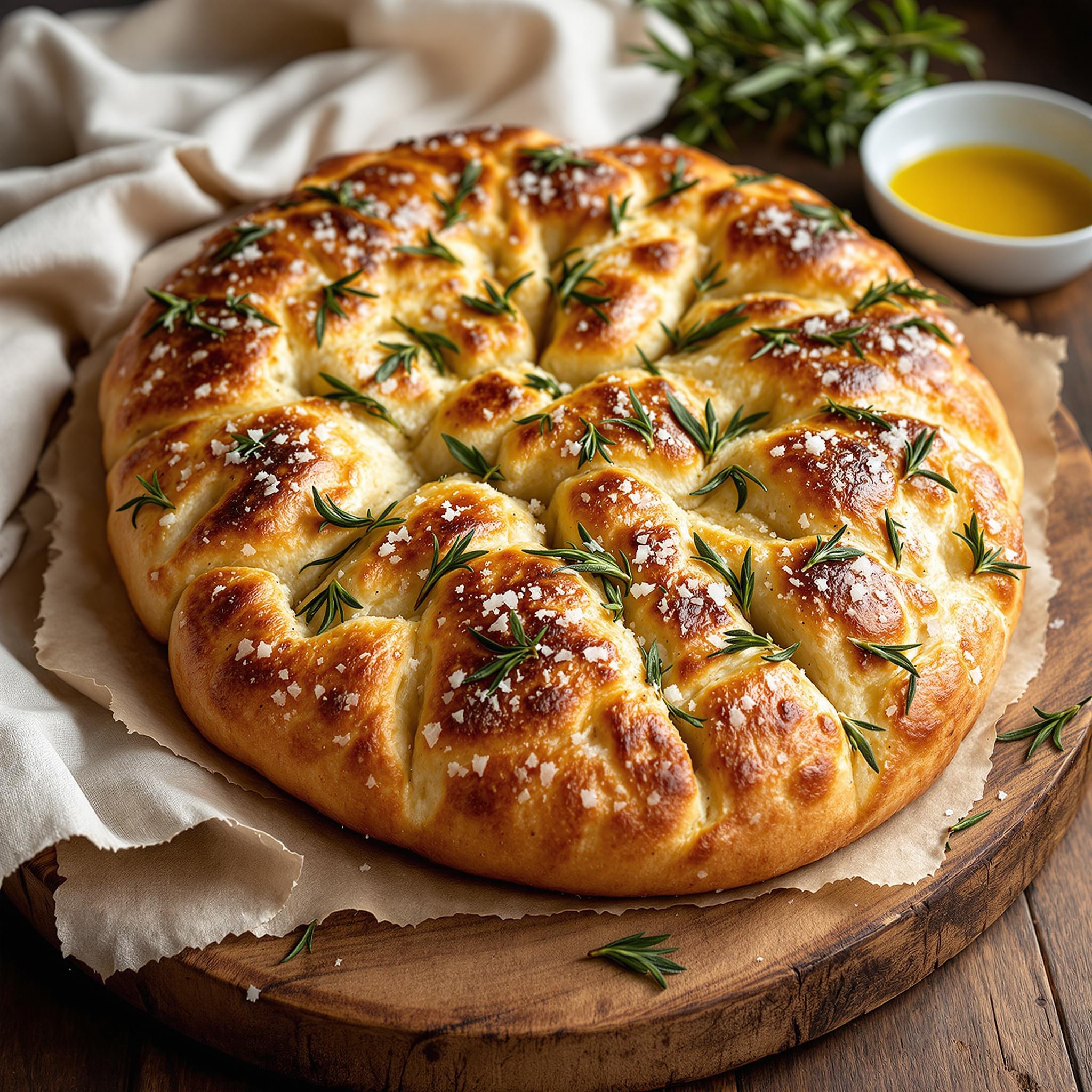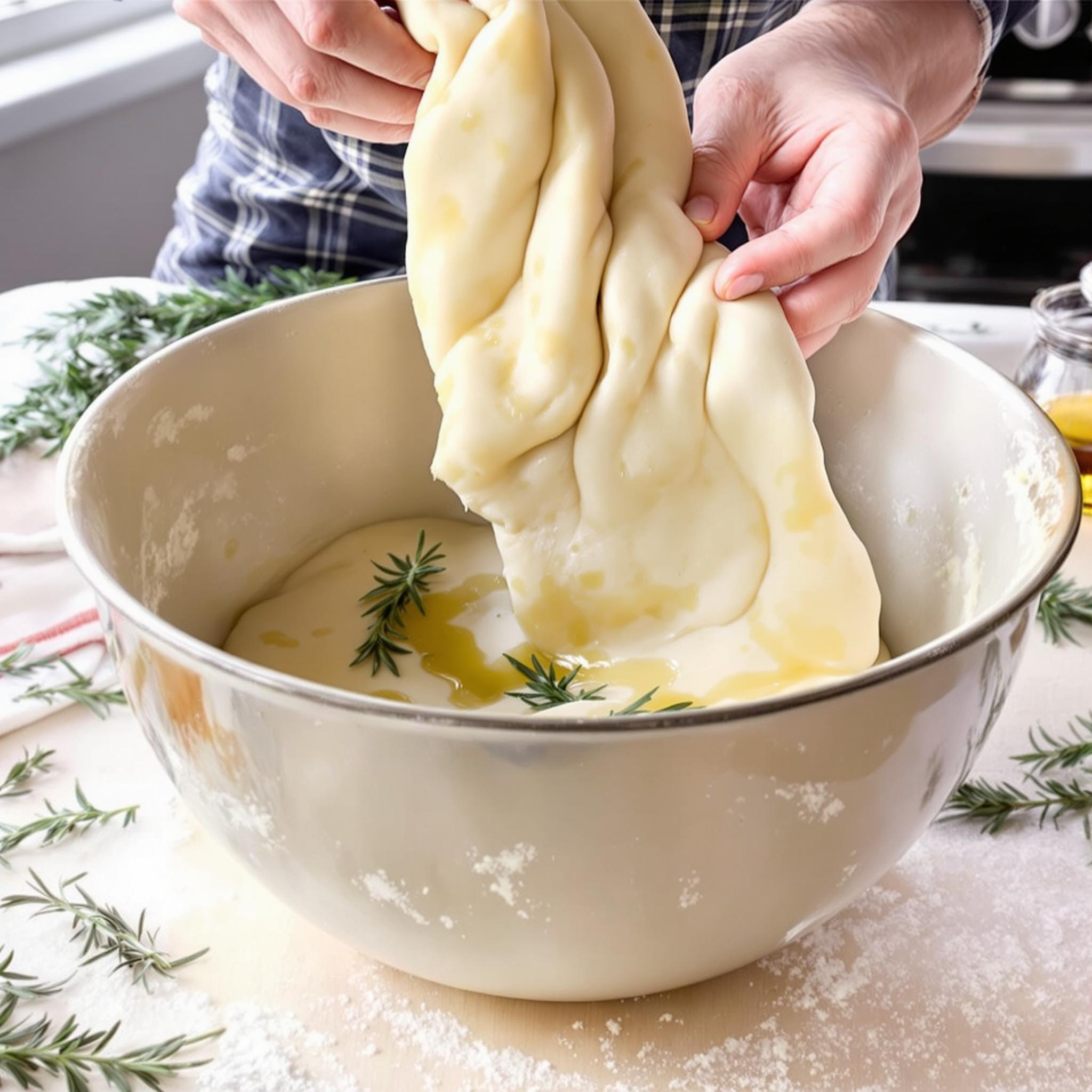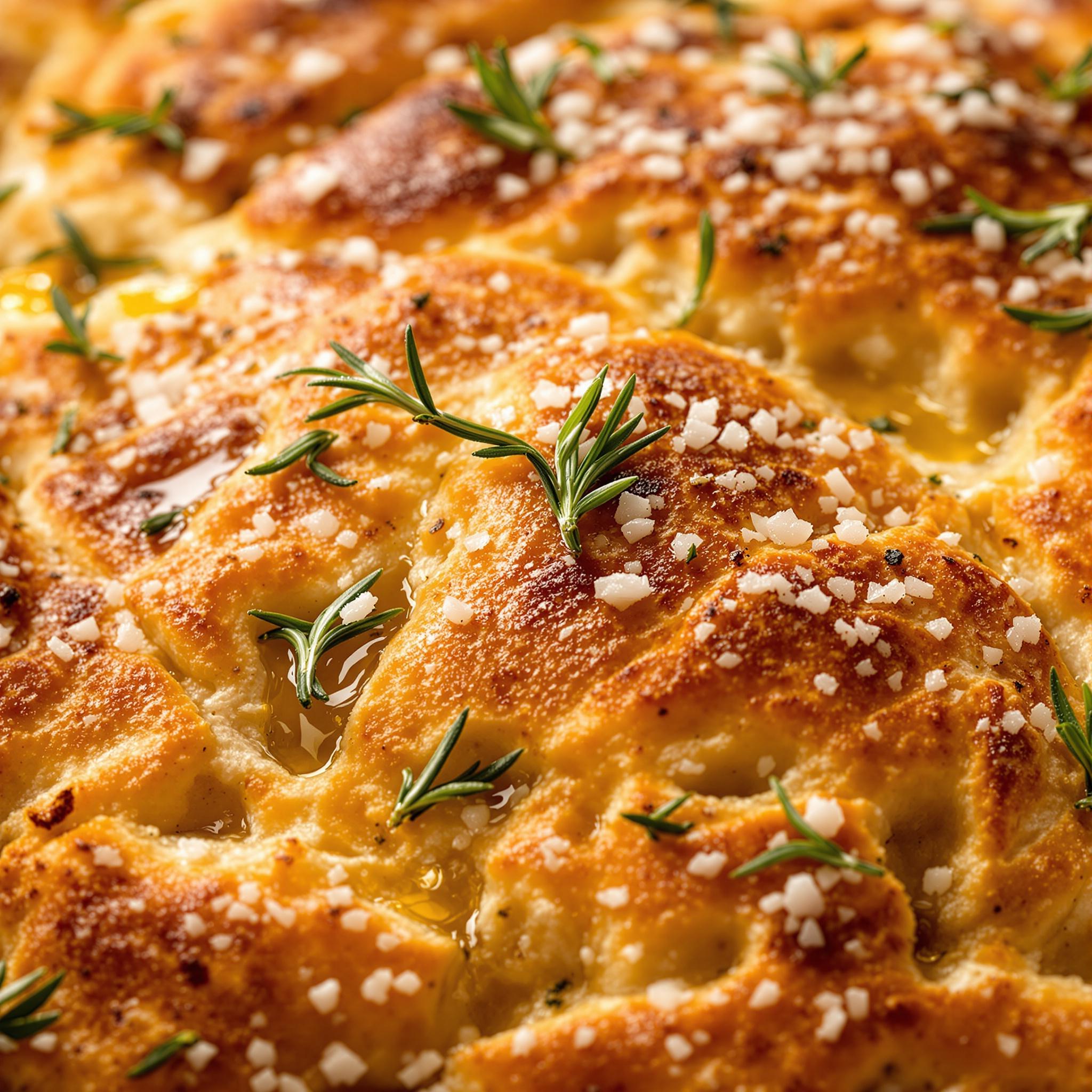
Discover the Magic of Rosemary Focaccia: A Bread Lover’s Dream
There’s something magical about homemade bread, especially when it’s as aromatic and flavorful as Rosemary Focaccia. This Italian classic is a crowd-pleaser, with its crispy golden crust, soft pillowy interior, and fragrant rosemary aroma. I first made this recipe on a rainy Sunday afternoon, craving comfort food that felt both rustic and indulgent. The moment my kitchen filled with the scent of fresh herbs and baked dough, I knew this focaccia would become a staple in my home. Whether you’re a seasoned baker or a beginner, this rosemary flatbread is simple, satisfying, and utterly delicious.
The Origins of Rosemary Focaccia: A Taste of Italy
Focaccia hails from the Liguria region of Italy, where it has been a beloved staple for centuries. Traditionally baked in wood-fired ovens, this flatbread was often topped with olive oil, sea salt, and local herbs like rosemary. Over time, variations emerged—some with tomatoes, olives, or caramelized onions—but the classic rosemary-infused focaccia remains a timeless favorite. My version stays true to its roots while incorporating a modern twist: a touch of honey in the dough for subtle sweetness. It’s a nod to my love for balancing flavors and textures.
Why You’ll Fall in Love with This Rosemary Focaccia Recipe
This homemade focaccia bread is everything you could want in a recipe: easy to make, packed with flavor, and incredibly versatile. The combination of fragrant rosemary, rich olive oil, and flaky sea salt creates an irresistible taste experience. Plus, the dough requires minimal kneading, making it perfect for busy days. Whether you’re baking for family dinners or weekend brunches, this herb-infused flatbread will leave everyone asking for seconds.
Perfect Occasions to Bake Rosemary Focaccia
Rosemary focaccia bread is ideal for so many occasions! Serve it warm alongside soups and stews during cozy winter nights, or slice it into squares for a picnic spread in spring. It’s also a showstopper at dinner parties, where guests can tear into its fluffy layers and savor the herbaceous goodness. Personally, I love baking it for Sunday lunches—it pairs beautifully with roasted meats and salads, creating a meal that feels both comforting and celebratory.
Ingredients for Your Perfect Rosemary Focaccia
- 4 cups all-purpose flour
- 1 packet (2 ¼ teaspoons) active dry yeast
- 1 ½ cups warm water (about 110°F)
- 3 tablespoons olive oil, plus extra for drizzling
- 1 tablespoon honey or sugar
- 1 tablespoon salt
- 2 tablespoons fresh rosemary leaves
- Coarse sea salt, for sprinkling
Substitution Options for Flexibility
If you’re looking to customize your rosemary flatbread, here are some ideas:
- Swap all-purpose flour with whole wheat or gluten-free flour for a healthier twist.
- Use dried rosemary if fresh isn’t available—just crush it slightly to release its oils.
- Replace honey with maple syrup or agave nectar for a vegan option.
Preparation Steps for Your Rosemary Focaccia
Step 1: Activate the Yeast
To start your homemade focaccia bread, dissolve the yeast and honey in warm water. Let it sit for about 5-10 minutes until it becomes frothy—a sign that the yeast is alive and ready to work its magic. While waiting, imagine the transformation happening before your eyes; those tiny bubbles mean your dough will rise beautifully later. Pro tip: Ensure the water isn’t too hot, as extreme heat can kill the yeast.
Step 2: Mix and Knead the Dough
In a large mixing bowl, combine the flour and salt. Gradually add the activated yeast mixture and olive oil, stirring until a shaggy dough forms. Transfer the dough to a floured surface and knead gently for 5-7 minutes until smooth and elastic. Feel the dough come together under your hands—it’s one of my favorite parts of baking! If you have a stand mixer, let it do the heavy lifting with a dough hook attachment.
Step 3: Let the Dough Rise
Place the dough in a lightly oiled bowl, cover it with a damp cloth, and let it rise in a warm spot for about 1-2 hours. Watch as it doubles in size, puffing up like a cloud. During this resting period, the yeast ferments the sugars in the dough, giving your rosemary-infused focaccia its signature airy texture. Patience is key here; resist peeking too often!
Step 4: Shape and Top the Focaccia
Once risen, transfer the dough to a generously oiled baking sheet. Use your fingers to dimple the surface, creating those iconic indentations that hold pools of olive oil. Scatter fresh rosemary leaves across the top and drizzle generously with more olive oil. Sprinkle coarse sea salt for a finishing touch. The glossy sheen of oil against the green herbs makes this step visually stunning.
Step 5: Bake to Golden Perfection
Bake your rosemary flatbread in a preheated oven at 425°F (220°C) for 20-25 minutes, or until golden brown. As it bakes, your kitchen will fill with the most heavenly aroma—a blend of toasted bread, fragrant herbs, and olive oil. Once done, let it cool slightly before slicing. Trust me, the wait is worth it!
Chef’s Tip: Elevate Your Focaccia Game
For an extra burst of flavor, infuse your olive oil with garlic cloves before drizzling it over the dough. Simply heat the oil gently with smashed garlic, then strain and use it as usual. This small step adds depth and complexity to your rosemary focaccia bread.
Time Required to Make Rosemary Focaccia
Here’s a breakdown of the time needed:
- Prep Time: 20 minutes
- Rising Time: 1-2 hours
- Cooking Time: 20-25 minutes
- Total Time: Approximately 2-3 hours
Nutritional Information
Per serving (based on 8 servings):
- Calories: 220
- Protein: 4g
- Fat: 8g
- Carbohydrates: 32g
- Fiber: 1g
Extra Information: Did You Know?
Rosemary has been used since ancient times not only for cooking but also for its medicinal properties. Its name comes from the Latin words “ros” (dew) and “marinus” (sea), meaning “dew of the sea,” reflecting its Mediterranean origins.
Necessary Tools for Baking Success
- Mixing bowls
- Measuring cups and spoons
- Baking sheet
- Parchment paper (optional)
- Dough scraper (optional)
Storage Instructions for Your Rosemary Focaccia
After cooling completely, store your rosemary-infused focaccia in an airtight container at room temperature for up to 2 days. To maintain its freshness, wrap it tightly in plastic wrap or aluminum foil. For longer storage, freeze slices in a freezer-safe bag for up to 1 month. When ready to enjoy, reheat in a toaster oven for a crisp texture.
If stored properly, your focaccia retains much of its original charm. However, nothing beats the taste of freshly baked bread, so try to consume it within a day or two for optimal flavor.
Avoid refrigerating your focaccia, as the cold air can dry it out. Instead, keep it at room temperature or freeze it for future enjoyment.
Tips and Tricks for Perfect Focaccia Every Time
- Don’t skimp on the olive oil—it’s essential for achieving that signature crispness.
- Use coarse sea salt for a satisfying crunch and bold flavor contrast.
- Let the dough rise in a draft-free area to ensure proper fermentation.
Serving Suggestions for Your Rosemary Focaccia
Serve your rosemary flatbread alongside creamy soups like tomato basil or mushroom bisque. It also pairs wonderfully with antipasto platters featuring cured meats, cheeses, and marinated vegetables. For breakfast, toast slices and top them with avocado and poached eggs for a gourmet twist.
Healthier Alternatives for Rosemary Focaccia
Looking to lighten up your focaccia? Try these variations:
- Whole Wheat Focaccia: Substitute half the all-purpose flour with whole wheat flour for added fiber.
- Vegan Focaccia: Replace honey with maple syrup and ensure all other ingredients are plant-based.
- Low-Sodium Option: Reduce the amount of salt and rely on herbs for flavor.
- Gluten-Free Focaccia: Use a gluten-free flour blend designed for bread baking.
- Olive-Topped Focaccia: Add sliced black olives for a savory kick without extra calories.
- Herb Medley Focaccia: Experiment with thyme, oregano, or basil for a new flavor profile.
Common Mistakes to Avoid
Mistake 1: Killing the Yeast
Using water that’s too hot can deactivate the yeast, preventing your dough from rising. Always check the temperature with a thermometer or your wrist—it should feel warm, not scalding. Pro tip: Aim for 110°F (43°C).
Mistake 2: Skipping the Resting Time
Rushing the process by skipping the rise can result in dense, flat focaccia. Allow ample time for the dough to double in size for light, airy results.
Mistake 3: Overloading the Toppings
While toppings enhance flavor, adding too many can weigh down the dough. Stick to a moderate amount of rosemary and olive oil for best results.
Frequently Asked Questions About Rosemary Focaccia
Can I make focaccia ahead of time?
Absolutely! Prepare the dough a day in advance and refrigerate it overnight. Bring it back to room temperature before shaping and baking.
What can I serve with rosemary focaccia?
This versatile bread pairs well with soups, salads, dips, and charcuterie boards. Its herby notes complement a wide range of dishes.
How do I know when the focaccia is done?
Look for a deep golden color and a hollow sound when tapped on the bottom. An internal temperature of 190°F (88°C) confirms doneness.
Can I freeze focaccia?
Yes, wrap cooled slices in plastic wrap and place them in a freezer-safe bag. Reheat in a toaster oven for best results.
Is focaccia hard to make?
Not at all! With simple ingredients and straightforward steps, even beginners can master this rosemary flatbread.
Why is my focaccia dough sticky?
Sticky dough often means it needs more flour. Add small amounts gradually until the dough feels manageable but still soft.
Can I use dried rosemary instead of fresh?
Yes, though fresh rosemary offers superior flavor. Crush dried rosemary between your fingers to release its oils.
How long does focaccia last?
Stored properly, it lasts 2 days at room temperature or up to 1 month in the freezer.
Can I add cheese to my focaccia?
Definitely! Fold grated Parmesan or mozzarella into the dough for a cheesy twist.
What makes focaccia different from pizza dough?
Focaccia is thicker and oilier, with a softer crumb and fewer toppings compared to pizza.
Conclusion
Baking rosemary focaccia is a joyful experience that fills your home with warmth and wonderful aromas. Whether you’re hosting a gathering or simply treating yourself, this herb-infused flatbread is sure to impress. So roll up your sleeves, gather your ingredients, and let the magic of homemade bread bring people together. Happy baking!

Equipment
- Mixing bowl
- Measuring cups and spoons
- Baking sheet
- Parchment paper (optional)
- Dough scraper (optional)
Ingredients
- 4 cups all-purpose flour
- 1 packet active dry yeast 2 ¼ teaspoons
- 1.5 cups warm water about 110°F
- 3 tablespoons olive oil plus extra for drizzling
- 1 tablespoon honey or sugar
- 1 tablespoon salt
- 2 tablespoons fresh rosemary leaves
- q.s. coarse sea salt for sprinkling
Instructions
- Activate the yeast by dissolving it and honey in warm water; let sit until frothy.
- Mix the flour and salt, then gradually add yeast mixture and olive oil, forming a dough.
- Knead the dough for 5-7 minutes; place in a lightly oiled bowl, cover, and rise 1-2 hours.
- Shape the dough on an oiled sheet, dimple the surface; top with rosemary, olive oil, and sea salt.
- Bake at 425°F (220°C) for 20-25 minutes until golden.


